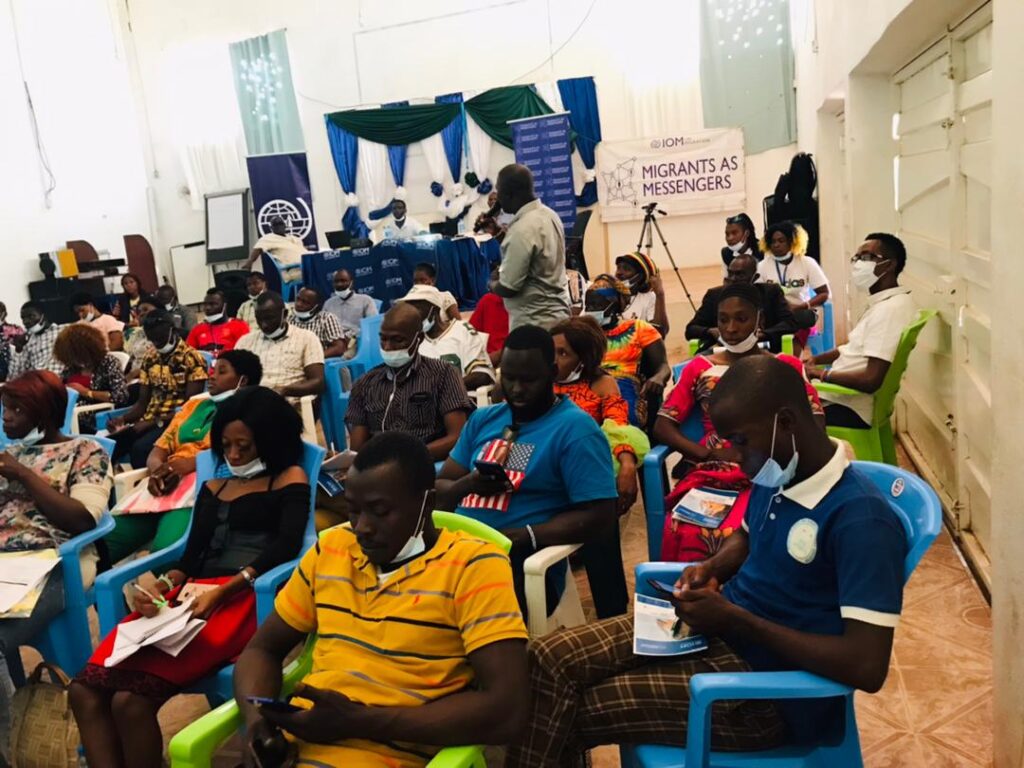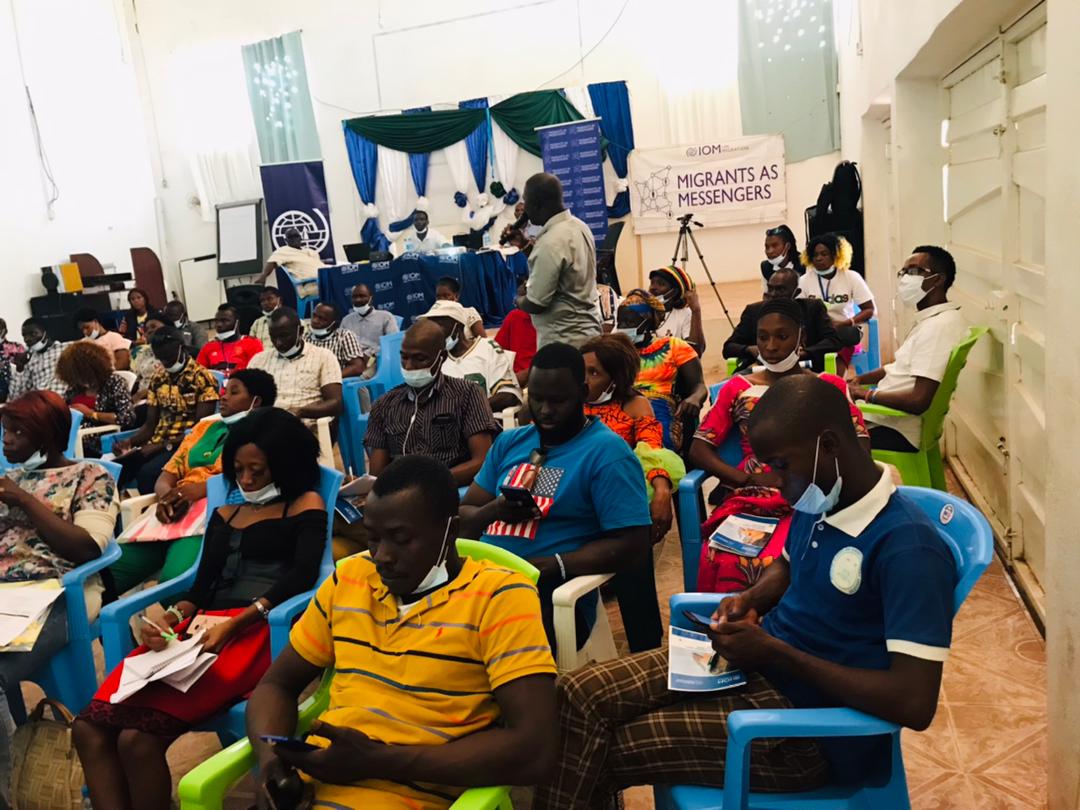A two-day training session on migration reporting for media practitioners and civil society activists in the northern district of Kambia has been conducted by International Organisation for Migration (IOM).
IOM is a body in charge of issues relating to global migration. The training was participatory and learner-centred seen in the brilliant responses and comments made by those who took part. They were allowed to share their knowledge and experiences gained on issues of migration over the years.
The training was held under the umbrella of MAM (Migrant As Messenger) project in which victims of irregular migration are used to tell their communities about their bitter stories and experiences during the risky trips across the seas and deserts.
It is hoped after the training that migration reporting would form part of journalists’ routine work and activists’ advocacy. Kambia is a border community littered with several porous borders making it prone to irregular migration than other districts in Sierra Leone. Residents and other stakeholders numbering over 50 also formed part of the training so that the message could be hammered home.
The training was delivered by a civil society activist, a journalist and IOM official, Mohamed Barrie who is the lead trainer and head of MAM project at IOM.
Key topics that enhanced participants understanding about challenges of migration were covered.
On the first day, the lead trainer offered a general overview of the session where he explained about the importance of the training. Migration in West Africa/Sierra Leone, Definition of migrants, migration environment and climate change, diaspora and remittances among others were topics covered by the MAM project boss.

A migrant, during the training, was understood as one who moves outside his habitual place of residence to another community. The youth were at risk of embarking on irregular migration since they possess the zest and zeal for the get- rich quick schemes.
Irregular migration, in the most popular language of the youth is known as ‘Temple Run.’
To dissuade the youth from ‘Temple Runs,’ the IOM official did not only confine himself within topics in the agenda but also shared the sad experience encountered by irregular migrants on their return.
“While on the journey to Europe or Asia, a good number of the migrants perished either on the Mediterranean sea or on the desert. The desert kills more than the sea owing to thirst and cyclones,” The MAM chief told participants.
He went on to state that the desert is over 1, 000Km long, three times the size of Sierra Leone adding that the surface area of the Mediterranean Sea is about 2, 500km, and its depth is beyond measure.
“It takes one hour for a coin dropped in the Mediterranean Sea to reach its destination,” Mr Barrie emphasised.
Apart from the perils of the sea and desert, the MAM boss went on, the rights, freedoms and civil liberties of migrants were also threatened away from home.
“When irregular migrants crossed over to countries’ borders, they often land in a detention camp, spend over 10 years to get a job, and these jobs are most times odd or menial ones,” Mr Barrie explained.
Perhaps the greatest difficulty that hunts irregular migrants is the unequal treatment and discrimination they face in their countries of destination. Irregular migrants hardly report abuse of their rights to the police owing to fear being required to produce their travelling papers during investigation.
One can barely exactly imagine the dangers that lie ahead of a migrant who failed to show his travelling documents upon demand by authorities.
A video on the sufferings migrants encounter on the high seas and the desert was also shown to the participants who reacted with comments and expressions that indicate their abhorrence for the dangerous journeys.
An official representing community of civil society organisations, Abdul Rahman Kays took the participants through on human rights. He also made a strong case about why is it important for media practitioners to cover migration issues.
The issue of human rights are very much germane to the discourse of migration since these rights including the right to life are under threat when entering people’s countries without adhering to legally accepted procedures.
The good side of migration was however paid equal attention to by Kays as participants broke into groups, and dilate on the positive and negative side of migration.
A lecture on ethical issues surrounding migration reporting was also handled by a media practitioner, Allieu Sahid Tunkara, editor of Nightwatch newspaper. Tunkara’s lecture was based on the ethics of interviewing a migrant upon return from their traumatic journeys. In his presentation, the Nightwatch editor relied on the Media and SLAJ (Sierra Leone Association of Journalists) codes of ethics which are sources of ethical guidelines for journalists in Sierra Leone.
Intrusion into grief, fairness and accuracy, door-stepping, subterfuge, protection of confidential sources, countering stereotypes among others was key topics he covered. The session was also learner-centred as participants were allowed to express themselves to gauge their depth of knowledge on migration reporting.
“Media practitioners owe it to the state to assist government achieve development objectives and solve crises when the need arises,” Tunkara appealed.
He therefore called on media practitioners to factor in migration issues in their magazine or phone-in programmes at least twice a week. Those in the print media, he went on, should also produce two news features a week at least.
The aim is to mobilise community and government action to nip in the bud incidents of irregular migration.
The second day was the continuation of the training session, and topics covered were effective story-telling, gender and migration, communication for development, social media, technology and migration, creating content and pitching for success.
The presenter defines Communication for development as the use of communication tools and processes to promote positive social and behaviour change. Migration is currently a global phenomenon that has posed several challenges for nations and states. It has always been a method of adaptation and contributes to the wealth, dynamism, survival and stability of societies.
IOM estimates that one out of every seven people, or one billion people, is a migrant. Migrants could be internal, that is, those who move but stay within their country of origin. They could also be international migrants meaning those who leave their country of origin for another country.
As of 2017, there were 763 million internal migrants and 272 million international migrants. The figure is equivalent to 3.5 per cent of the world population according to UNHCR, (2019).
Records also show that 60 million forcibly displaced (those who have fled a situation of conflict and persecution and more than 20 million of whom have fled outside their country of origin). Poised to reduce incidents of irregular migration, the training sessions and awareness raising campaigns will continue with the hope of getting there.


